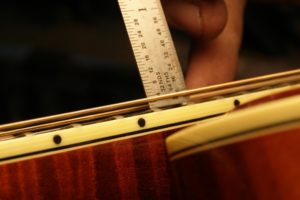Play Easier, Sound Better
You may not realize we have a Support Page here, to answer some common questions Bruce receives from players. Following are a few examples.
Don’t hesitate to contact Bruce to discuss your concerns and questions!
How do I check the Action and Intonation?
A good medium action on your mandolin is 1/16” from the top of the 12th fret to the bottom of the G string and a hair less on the E side. Most mandolins will have some way to adjust your action at the bridge.
If you’ve done either a major truss rod or action adjustment, the intonation may need to be tweaked. If the instrument intonates sharp at the 12th fret, loosen all but the outside G and E strings and gently move the bridge towards the tailpiece checking the intonation on those two outside strings as you go. Small movements of the bridge will serve you well in this process. If it intonates flat, move the bridge towards the peghead. When you are satisfied with the intonation you can bring the remaining strings up to pitch while insuring the saddle and bridge base haven’t started leaning towards the peghead as you go (we’ve had many sent in that turned out to be the bridge leaning, robbing the instrument of tone and volume).
Note: If you play with a high action, your bridge placement will be slightly closer to the fingerboard.
When, and how, do I adjust the truss rod?
Please read Bruce’s full blog article on truss rod adjustment.
The correct order in basic setup: Truss rod, Action, Intonation.
TRUSS ROD ADJUSTMENT
The neck should be near flat as you sight down or lay the edge of ruler down the length of the fretboard on both the treble and bass edges. Under full string tension, just adjust the rod 1/4 turn at a time, checking the neck as you go. The neck may groan and pop a little. If the neck is slightly twisted, use the first edge to reach true as a good place to stop.
1. To take relief (bow) out of your neck, tighten the truss rod. (turn CLOCKWISE)
2. To relieve hump in the neck, (rare, unless you’ve over tightened the rod) loosen the truss rod. (turn COUNTER CLOCK-WISE)
3. If the rod will not move or spins freely and you still have a bow, it would be best to visit a local luthier or send it to Bruce.
CHECK ACTION: More often than not you’ll have to adjust the action (playability) after a successful adjustment session (the fingerboard is flat). Tightening the truss rod, bringing the neck back to true, will lower the action. A good medium action on your mandolin is 1/16” from the top of the 12th fret to the bottom of the G string and a hair less on the E side. Most mandolins will have some way to adjust your action at the bridge. If you’ve over tightened the rod, the instrument will buzz on the first five frets at a good action.
CHECK INTONATON: If you’ve done either a major truss rod or action adjustment, the intonation my need to be tweaked. If the instrument intonates sharp at the 12th fret, loosen all but the outside G and E strings and gently move the bridge towards the tailpiece checking the intonation on those two outside strings as you go. Small movements of the bridge will serve you well in this process. If it intonates flat, move the bridge towards the peghead. When you are satisfied with the intonation you can bring the remaining strings up to pitch while insuring the saddled bridge base haven’t started leaning towards the peghead as you go (we’ve had many sent in that turned out to be saddle and bridge base leaning robbing the instrument’s tone and volume).
Note: If you play with a high action, your bridge placement will be slightly closer to the fingerboard.
What is wrong when my mandolin buzzes, goes flat, sharp, etc. while playing…
Go Here for the answer to that question, and more!


